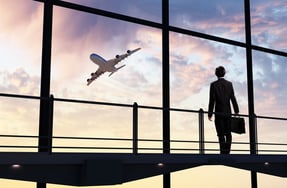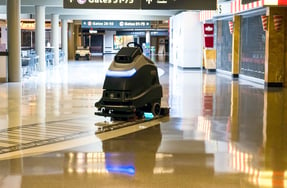The evolution of technology is changing everyday tasks and even though COVID-19 has disrupted the current ways of business, it has also paved the way for advanced technology.
The health crisis has prioritized cleaning efficacy in airports and other high-traffic locations like never before. It has also introduced the challenge of restoring traveler and occupant confidence.
But how do you do more with limited resources and also rebuild confidence?
Watch: Brain Corp and Tennant: Solving Today’s Airport Cleaning Challenges: How to Restore Traveler Confidence Through Best Practices & Robotics – Featuring Don Toole, Senior Vice President Sales and Marketing at Flagship.
The answer may be found in artificial intelligence (AI) and advanced technology. AI is changing airports and large facilities because it provides some significant solutions to increase comfort and create more productive environments.
One significant way AI improves cleaning practices is that it can help improve sanitation and decrease the risk of disease transfer.
Airport Challenges
When 58% of travelers say they are avoiding air travel because of COVID-19, you know that significant changes need to be made to regain passenger trust. Beyond that, 33% of travelers say they will continue to avoid travel to prevent infection.
What are some of the latest best practices for airport cleaning that decrease the risk of virus transfer and improve safety? How can you still maintain the airport image that travelers expect?
Supplement the Workforce
Floor scrubbing robots that leverage AI technology allow airports to reallocate labor and move their time to higher priority areas. Used as a supplement to human employees, they eliminate the need for workers to perform many simple and repetitive tasks and allow them to focus more on complex, thought intensive responsibilities. This will allow you to reassign some jobs into higher value duties that will increase traveler experience and improve your return on investment.
Autonomous robotic cleaners for airports can provide
- Additional hours for sanitizing high-contact surfaces
- Manpower to assist travelers
- More distance between humans in order to help keep employees and travelers safer
- Support for workers
- Help with filling the void of absenteeism
- Up to the minute reporting and analytics of performance
Introducing autonomous robotic scrubbers can have a range of different impacts on the entire floor care operation, from reducing budget to maximizing efficiency and productivity.
What are the key benefits?
The possibilities are quite “brilliant”, similar to the well-cared floors that could be beneath your feet.
Scrubbers that leverage AI technology and sensors to clean autonomously
- Leverage teach and repeat methodology
- Safely navigate high-traffic areas within airports, sensing luggage, travelers, children and employees
- Are easy to deploy and constantly adapt to the environment
- Allow you to implement solutions that can be more sustainable well into the future
Depending on the model, it can expertly navigate complex, real-world environments and enhance the overall workmanship of the floor care team. The autonomous floor care machine should be capable of speaking directly to your current CMMS and keep all reports up to the minute - providing a full picture of your floor care at any time, including in-depth reporting and coverage maps.
Their potential to promote human involvement to higher-level functions means more effective use of human capital and reduced costs in the long term.
Real World Experience
As automation and innovation infiltrate your day-to-day, creating and seizing opportunities for future value become more important.
This year, Flagship has been able to reallocate 6,000 hours by utilizing robotic cleaners and expects the number of hours to surpass 10,000 by the end of 2020. By deploying cleaning robots, valuable time has been given back to employees and that enabled them to focus on additional detail cleaning and passenger satisfaction.
AI Can Help Other Parts of Your Airport Too
AI and other advanced technology resources can also help you reduce the number of high-touch areas in your airport by removing the “touch” portion of things that people do every day.
In bathrooms, no-touch flushing, soap dispensers, faucets, air dryers or paper towels can help reduce the transmission of several germs. In high traffic areas, automated doors and no-touch antiseptic dispensers can help cut down on germ-ridden hands from passing viruses around the airport.
Current challenges have helped bring to light that employees can be more productive by working side by side with machines.
When your airport is ready to implement the high-tech knowhow of autonomous floor care, make sure you work with a company like Flagship that understands how to create knowledgeable teams composed of high-tech devices and high-value tasked staff.
These are challenging times but Flagship's customizable approach to your airport's needs will help you protect employees and travelers now and into the future.
Email an airport facilities expert today and get the help you need to keep your airport healthy and safe.





Leave a Comment